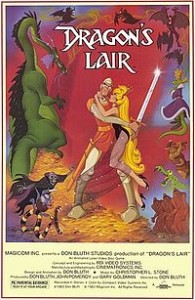315th played so far
 Genre: Adventure/Interactive Fiction
Genre: Adventure/Interactive Fiction
Platform: Arcade
Year of Release: 1983
Developer: Advanced Microcomputer Systems
Publisher: Cinematronics/Taito
Today, again, we play one of the games we (or I) have been most curious about since the start of this blog.
Dragon’s Lair is an early adventure games, but using the Disney animation style we know from the 80s and earlier – a style you didn’t see in video games for about another decade. We couldn’t really realistically pull it off before then. Yet here, in a Laserdisc-based arcade cabinet, a lot more is possible – thanks to the ability to switch between video tracks (a lot of this based on playing the right video bit).
Our Thoughts
Now this was a surprise. Based on the vague descriptions we saw, as well as the screenshots, we were expecting something more conventional to an adventure game – follow hints, solve puzzles and explore the area.
Instead… well, these days you would see the game as (literally) a sequence of QTEs, or some sort of rhythm game. You basically go through scenes, pressing the right move buttons to proceed (directions and sword). I’ll be honest, I had two advantages, both from playing the Steam updated version rather than the original arcade cabinet. First, you got button prompts – I have no clue how you would have worked out what to press and when without them. Second, unlimited continues meant that we had unlimited attempts to finish the game. Without it, I’m not sure I’d have made it past the second screen.
On the whole though, it feels mostly like a rhythm game. Get the timing right, press the right buttons, play the game. You’re just playing to a cartoon rather than to a music track. Beyond that, though, it’s mostly just fun to watch the graphics. Ideal, then, is that the Steam version included a ‘Watch game’ mode, which basically runs through all the scenes at optimal speed. It takes 9 minute 35 by the way – not bad for a quarter (once you mastered it). What becomes disappointingly clear then, though, is the lack of story. The scenes don’t link to each other (displayed by how they randomly repeat as you play the game) and the only bit you’ve got is rescuing the princess at the end – a fairly generic affair.
Talking about the ending of this game brings me to the topic of the damsel in distress. Whilst we all know the big reveal of Samus was a watershed moment in terms of women in gaming watching the exchange between our hero and Princess Daphne was pretty uncomfortable. Here we have the stereotypical blonde airhead armed with girly squeals and a vacant expression. I am not a feminist but more of an equalist, so this character got under my skin a bit. Nowadays a character like this would be more explicitly tongue in cheek (out of necessity to avoid controversy more than anything)… or at this I’d like to think so.
That’s not to say the game isn’t fun, but the depth that it seems like it should have isn’t really there. As a setup and setting it shows promise, but video game storytelling just wasn’t there yet. A shame really.
Final Thoughts
The game looks nice and there’s some interesting puzzles in the game, but on the whole it just doesn’t work out as interesting. You can see where the arcade appeal comes from and how it works out as an engaging challenge, but for casual play now it gets repetitive – having to do the same jumping puzzles five times (with the platform falling down) was a bit much. A shame, really – and a shame they didn’t make more games like this where they could expand on the idea.